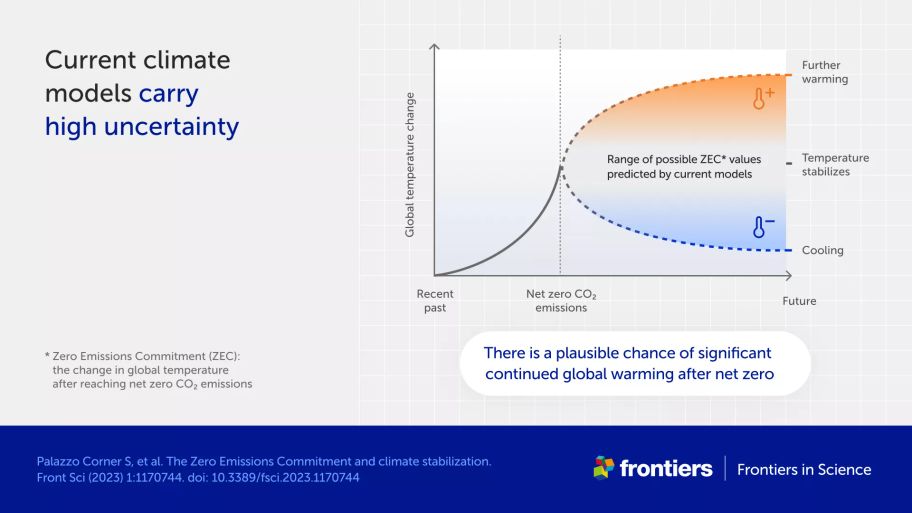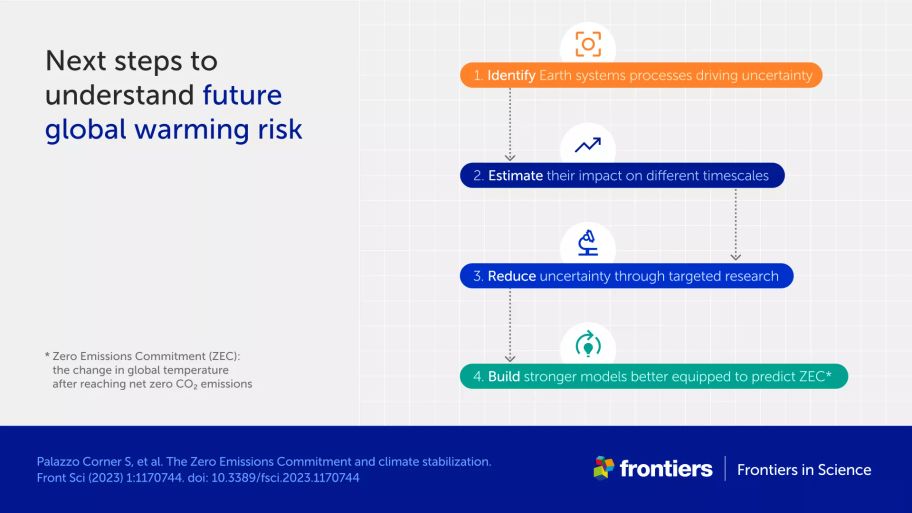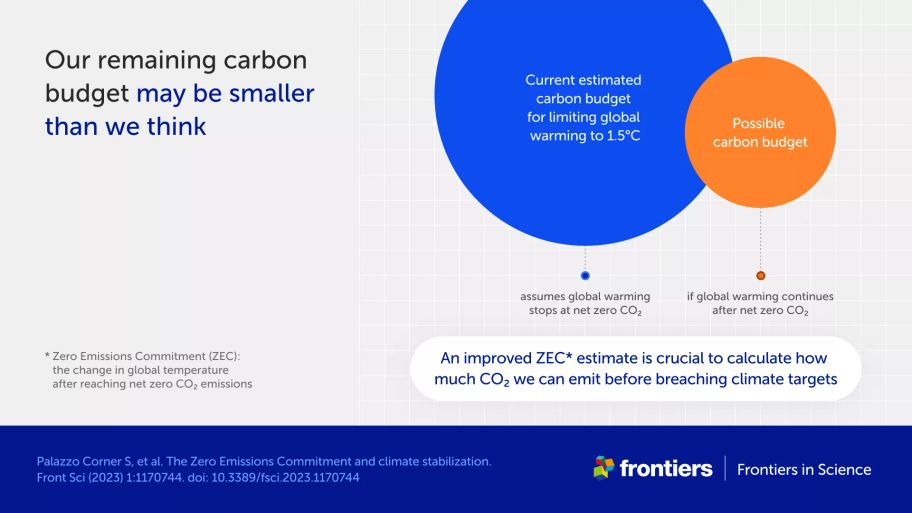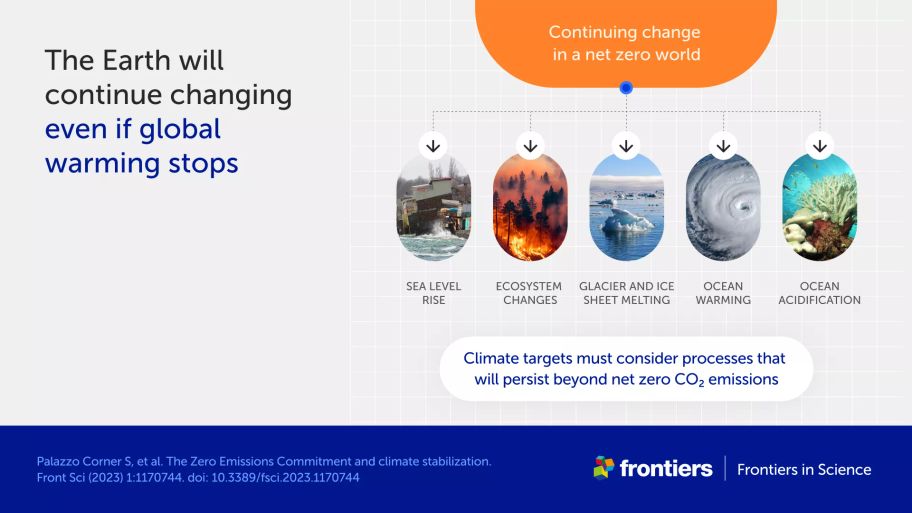The Zero Emissions Commitment and climate stabilization
Explainer
Front Sci, 14 November 2023
This explainer is part of an article hub, related to lead article https://doi.org/10.3389/fsci.2023.1170744
Predicting the risk of continued global warming after net zero
Halting global warming, and consequent climate change, is this century’s most important challenge. Science has shown that greenhouse gas emissions (primarily CO₂ from the burning of coal, oil, and gas) has led to 1.2°C of planetary warming since the industrial revolution. Climate scientists’ latest best estimate is that warming will stop once these emissions reach ‘net zero’ – that is, when we only emit as much CO₂ into the atmosphere as we remove. This understanding is the basis for net zero targets set by countries and companies in recent years.
But as Palazzo Corner et al. point out in their Frontiers in Science lead article, model-based estimates of warming after net zero come with a high uncertainty range. Crucially, these estimates include the possibility of significant continued warming – a risk that is currently overlooked in climate mitigation and adaptation policies.
To better understand warming after net zero – called the ‘Zero Emissions Commitment’ (ZEC) – Palazzo Corner et al. undertook the first comprehensive analysis of Earth system processes controlling global temperatures and our knowledge gaps for each. Based on this, the authors provide a pioneering framework for building climate models that are better equipped to predict ZEC.
This ‘explainer’ outlines the article’s key points and their critical implications for climate policies.
What is the Zero Emissions Commitment (ZEC)?
ZEC is the technical term for the amount of temperature change we can expect after greenhouse gas emissions from human activities reach net zero. A positive ZEC indicates further global warming will occur, a negative ZEC indicates temperatures will go down, and a ZEC of zero indicates no further global temperature change.
Why would global temperatures continue changing in a net zero world?
Global temperatures are determined by complex interactions between greenhouse gases and natural processes in the oceans, land, and atmosphere. Some of these so-called ‘Earth system’ processes cause temperatures to increase while others cause temperatures to cool. When all are in balance, then global temperatures remain stable.
Rising levels of CO₂ and consequent global warming have triggered changes in many Earth system processes, including increased heat uptake by the oceans, disruptions to carbon cycling on land, and alterations to cloud cover. Such disturbances have already disrupted our planet’s equilibrium, and may not all stabilize at the same time. Many processes will continue to adjust long after we reach net zero CO₂, until a new equilibrium is reached – with some of these continued changes potentially driving further warming.
One example is the melting of polar ice. By reflecting the sun’s energy back into space, ice floating on seas in the Arctic and Antarctic helps to keep global temperatures down. But as this ice melts due to rising air and ocean temperatures, solar energy is absorbed instead of reflected. This leads to further warming and further loss of ice, in a positive feedback loop.
How likely is further global warming after net zero CO₂? And how much could it be?
Our current models and understanding of Earth system processes suggest that when CO₂ emissions stop, we can cautiously expect that global warming will also stop. However, these predictions come with a large uncertainty range that includes the possibility of both decreasing temperatures and further warming after net zero.

The expert assessment presented in the article points more strongly toward the likelihood of continued warming after net zero. The authors state this prospect is both plausible and significant. Moreover, they suggest that current best estimates of a 1 in 6 chance that ZEC could exceed 15% of total global warming could potentially be revised upward. This means that if global warming at net zero is 2°C, the final temperature change could be higher than 2.3°C. Global warming of this magnitude would worsen extreme weather and other environmental events, reduce biodiversity, and threaten lives and livelihoods around the world.
Why are ZEC predictions so uncertain?
To estimate ZEC, scientists develop models that simulate how different Earth system processes respond to greenhouse gas levels (particularly CO₂) and other variables. While enormous progress has been made, modeling the full scope and complexity of all processes over long timescales remains challenging.
The authors identify five categories of uncertainty in ZEC:
processes known or suspected to impact ZEC, which are currently missing in models
processes with high uncertainty, whose uncertainty and interactions are not sufficiently represented in models
biases in modeling frameworks
the possibility of abrupt change or irreversible tipping of Earth system dynamics
potential process dependencies.
How can we better predict the risk of future global warming?
As an initial step toward improving ZEC predictions, the authors present the first comprehensive analysis of 26 major Earth system processes affecting global temperatures. For each system, the international team of climate scientists:
mapped expected changes after net zero
identified the drivers of ZEC uncertainty
quantified the process’ likely impact on ZEC from decades to millennia.
This expert assessment serves as the basis for the authors’ proposed next step: an extensive research program to fill knowledge gaps and reduce uncertainty. The pioneering framework outlines targeted research questions, experimental strategies, and the level of urgency for each line of investigation. The research outcomes will help build a suite of scientific tools to help us better understand temperature change after net zero.

How should climate policies address possible warming after net zero?
The 2015 Paris Agreement commits countries to reducing their greenhouse gas emissions, with the aim of limiting global warming to well below 2°C and ideally below 1.5°C. Based on this, scientists have calculated our remaining ‘carbon budget’: the amount of CO₂ that can be emitted before these limits are breached. These calculations typically assume a ZEC of zero – and crucially, do not include the full uncertainty range of current ZEC predictions.
We may be lucky: if ZEC is negative, meaning global temperatures cool after net zero, then we have a bit more leeway in meeting current climate targets – or we could achieve safer levels of global warming sooner. However, the article’s finding that ZEC is more likely to be positive implies the already small carbon budget could be cut further to ensure we stay below the 1.5°C limit.

We may also need to achieve global net negative CO₂ emissions to bring global warming to a halt. This would require the development of sustainable, safe, and reliable options for long-term removal of CO₂ from the atmosphere.
The long-term consequences of CO₂ emissions also imply that while net zero remains an essential milestone, it might not be enough to stabilize the impacts of climate change. As mentioned above, even if global temperatures do peak at net zero, the Earth’s natural systems will continue to adjust to the disturbance that has already occurred. Ongoing changes such as continued heating and acidification of oceans, rising sea levels, and disruption to ecosystems could persist for centuries to millennia, and should be factored into the assessment of safe warming limits as well as climate adaptation plans.
Overall, the article underscores the urgent need to reach net zero and keep the initial disturbance of the Earth system as low as possible – and so avert avoidable future climate risks.
